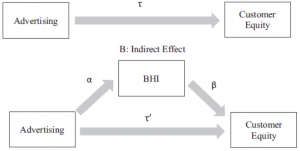Brand health – how is yours affecting customer equity?
Share
Dr Abas Mirzaei and Associate Professor Chris Baumann discuss the findings of the impact of brand health on customer equity, and the implications these have for brand managers.
The impact of brand building has been a contentious topic in the advertising world. While many marketers know it can be powerful, its impact can be difficult to prove, let alone measure, which means it can also be difficult to link to sales objectives.
In our recent study, ‘The impact of brand health on customer equity’, we empirically demonstrate the impact of brand health on customer equity creation.
We prove there is a mediating role of brand health in the advertising-customer equity relationship. Our study’s findings show that building healthy brands increases the effectiveness of advertising efforts in creating customer equity.
Understandably, practitioners traditionally focus on advertising effects on sales with a short-term perspective. Advertising was generally designed to contribute to short term sales of products, services and experiences, but the new way of thinking is that it should not only sell short term, but also contribute to brand equity over time.
Two areas have been largely overlooked in the battles for share of mind. First, the long-term impact of advertising on customer equity is unclear. Second, advertising’s impact on customer equity with and without the mediating role of brand health warrants investigation, or in simpler terms: what are the effects of advertising on customer equity? Direct or indirect via brand health?
Our paper probed the interactions between brand and customer assets. Applying our new brand health index (BHI), introduced in the ‘Journal of Brand Management’, we tested how brand health relates to customer equity, and to what degree there would be a mediating effect on the advertising-customer equity association.
We conducted our longitudinal study in three services industries: department stores, airlines and banking. We found that indeed brand health positively impacts customer equity. It was interesting to see that BHI’s impact is not the same across the three industries. Importantly, we could demonstrate that brand health mediates the association between advertising and customer equity in all industries.
Examining such associations is important since customer equity is a relatively new construct and is not yet well understood, nor researched. In fact, it is unclear what ‘drives’ customer equity, and our study is designed to answer this question.
Theoretically, we view customer equity at the individual customer level as the customer lifetime value (CLV). In our study, we apply the well accepted macro level model by Lim and Lusch (2011) to capture customer equity for 24 businesses, in three industries, over a 12 year period.
Findings
Direct and indirect effects of advertising on customer equity via brand health
Direct effects
Our study found that brand health positively relates to customer equity in all three industries. Looking at direct effects, we found that on average, a one unit increase in brand health results in an 11% increase in customer equity for airlines.
For banks, building healthy brands results in a 20 per cent unit increase on customer equity. The strongest effect we found for department stores: One unit increase in brand health gives a 40% unit increase. It is clear that building healthy brands secures greater future cash flow and customer equity.
Indirect effects
Looking at indirect effects, advertising impacts customer equity via brand health 6.8% of a unit in the airlines industry and explains a remarkable 40% of the variation in customer equity. Stronger indirect effects we found for advertising on customer equity in the banking and department store categories with 7.4% and 8.1%.
Implications
The findings of our study have important implications for managers, allowing for budget optimisations and better resource allocation.
Managers should use our framework to test the effectiveness of their marketing actions and this way build customer life time value and customer equity. Our tested framework allows managers to probe the mediating impact of brand health on customer equity. Brand-orientated and customer-orientated companies should use our approach to monitor the dynamics of marketing actions and marketing assets (i.e. brand equity and customer equity) with a long-term lens.
We offer a new long term perspective with our framework in times of intensified competitiveness, coupled with decreased customer loyalty. We can observe such phenomena not only in the industries we have researched, but also in network providers, insurance, tourism and online shopping and booking sites.
_
Dr Abas Mirzaei is Assistant Professor in marketing at Macquarie University.
Chris Baumann is Associate Professor at Macquarie University.
Header image copyright: rocketclips / 123RF Stock Photo
















